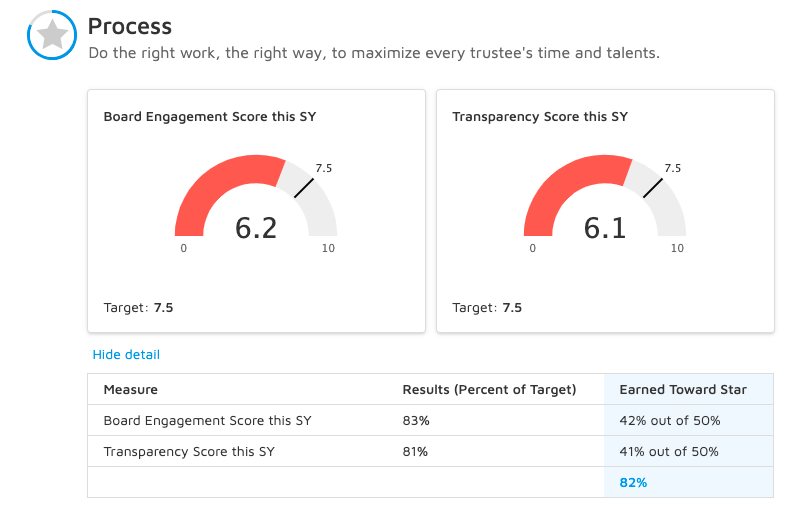
How to Keep Your Board Members Engaged
“Board engagement consistently has become one of our primary challenges,” says one board member.
We conducted a survey of our members — thousands of charter school board members, CEOs, and staff who represent hundreds of charter organizations nationwide. And what came up again and again, in passionate comments, was your board member engagement woes.
For many, the hardest part about your board work is, as this board member put it, “having board members who have the time and energy to commit as members of the board….board members want to be involved but may be committed in far too many other ways.”
We

Whether it seems like one or two trustees are lagging, or half the board, you feel like you could do more to keep your board engaged.
And while early on, your board’s work might largely be fueled by the heroic efforts of one or two founding trustees, this approach is not sustainable. Over time, your board must mature so that every trustee is contributing to the fullest.
But it’s not easy to keep everyone on track and keep your committees going strong. Especially as you grow your organization and expand your board. Even still, you’re most likely certain of this: your board members are amazing people with a lot to offer the kids you serve.
Here’s how to boost your board’s engagement. And put all of that potential into practice.
- Communicate effectively with your board members.
- Provide every new board member with an orientation.
- Ensure board members know what’s expected of them.
- Connect each board member with the mission. And with each other.
- Run great board meetings. And evaluate your meetings regularly.
- Try a no-stress board member book club.
- Use board goals to show your board the progress you’re making.
- Measure board member engagement with data, not assumptions.
Communicate effectively with your board members.
Find a balance between not overcommunicating or overwhelming your busy board members…and keeping the governance team connected.
This is especially important if you’re trying to minimize the amount of interaction your board members need to have with your staff. After all, your staff have a lot of things to do beyond supporting the board.
Communicate the right information, consistently, to the right people, in a way that they’ll actually use what you provide.
Effective board and committee meetings are vital to good communication {more on those meetings later}.
Beyond that, for some boards, a monthly reminder about what your board should be doing, when, is helpful. If you’d like to try that, check out our annual calendar to plan out your notices.
Provide every new board member with an orientation.
New board members need orientation and guidance. They need to understand your organization, your board, and what’s expected of them.
For example: a new board member won’t automatically grasp the complexity of your organization. They’ll need help to understand your organization’s history, current challenges, and future direction.
Typically, the Governance Committee organizes the board orientation with assistance from the board chair and CEO.
You may find it useful to add several board members at one time so that you can orient them together, and so that you avoid constantly catching new trustees up to speed.
BoardOnTrack’s Documents hub makes it simple to have all of your board member orientation resources all in one place, always ready for you to share with your next board member.
Ensure board members know what’s expected of them.
One of the best strategies to boost engagement is to provide your board members with well-defined, written job descriptions that describe their roles and responsibilities as a trustee of your organization.
Make it easy for them to get involved by laying the groundwork, setting organizational objectives that provide a variety of opportunities that cover various skill sets.
By having these basics in place, you’ll provide a clear pathway for trustees to use their talents to make an impact.
Connect each board member with the mission. And with each other.
Make sure that each board member is engaged in meaningful work on behalf of your charter school.
Each board member should actively serve on a committee or contribute to another results-oriented project.
They should have tasks assigned to them that clearly contribute to their committees’ goals. And it should be clear how those committees’ goals roll up to the charter school’s larger goals.
Provide opportunities for board members to participate in school activities. Coming into contact with the mission is key to staying engaged and passionate. And what better way to do that than to see your school’s work in action?
Connect with each other outside of your board and committee meetings, too. Conduct board retreats and outings so individuals develop rapport and feel comfortable challenging one another when the work gets challenging. This is key to a high-functioning governance team.
Run great board meetings. And evaluate your meetings regularly.
To keep stellar trustees engaged and contributing to the fullest, the single most important thing is to tighten up your board meetings.
Board meetings that help boost engagement typically last no longer than two hours, keep to the established
To evaluate your meetings, give each board member a turn at evaluating the board meeting by sharing observations and feedback at the end of each meeting.
Focus your evaluation on these key questions:
- What did we do here to further our mission?
- How much of our time was spent reporting on the past vs. planning our future?
- Did we stick to the agenda?
- Was there equal participation by board members?
- Was this meeting effective? Why or why not?
- What could be done to improve our next meeting?
Try a no-stress board member book club.
If meetings are a challenge, pick up our book — it’s the definitive guide to board meetings for charter school boards.
Make it simple to participate.
Buy each board member a copy of the book. Pass them out at your next board meeting.
Host a no-pressure, 20-minute book club discussion at your next board meeting. You might be surprised at the great ideas that surface.
For an even simpler option, choose an article to read and discuss together.
You could share this article with your board, or anything else from the BoardOnTrack blog. Or, take a look at your state association’s website, the National Charter School Resource Center, or your favorite source for board inspiration.

Use board goals to show your board the progress you’re making.
At each board meeting, review your board’s goals for the year and your progress towards meeting {or exceeding} them. And envision the future together.
BoardOnTrack makes this easy with the goals dashboard. If you’re a BoardOnTrack member, just pull up the dashboard at each of your board and committee meetings to make sure you’re tying your board members’ time back to the reasons why they’re there.
Ask board members to think about what your organization will be like in twenty years.
Pretend that you are a visitor to the future. You go to see your charter school(s). Write down what it looks like, what is happening there, who is there, etc. Then share your thoughts. Discuss how to create a bridge from where you are now to where you want to be. What is the role of the board in getting there?
Measure board member engagement with data, not assumptions.
BoardOnTrack is built to measure individual board member engagement as well as overall board engagement with data points like meeting attendance and RSVPs, meeting packet downloads, and more.
On a scale of 1-10, you see clearly how engaged your board is as a whole — and how engaged each board member is — based on key data points like:
- Attendance rate at all events which you were invited to
- RSVP rate to all events which you were invited to
- Download rate of available agenda packets, in advance of meetings
- Activity rate based on monthly logins
With data to guide your conversations, the hard conversations — like addressing a disengaged trustee — become easier. Because it’s not about opinions, assumptions, or personalities; it’s about the data.
So BoardOnTrack members have access to that data, at a glance, in their OnTrack Score. Here’s an example:


Boosting board member engagement takes constant attention.
Following these steps will most likely help to boost your board members’ engagement, whether your board is highly engaged or highly disengaged.
But the most important tactic is not a one-and-done activity. It’s sticking with the focus over time.
Ensure that you know who on your board is responsible for maintaining a focus on measuring and nurturing board member engagement. Be honest with yourselves when it’s a problem. And be willing to try new approaches to keep making things better.

Mike Mizzoni
With years in higher education, board governance, law, and state and local politics, Mike provides leadership and governance training to BoardOnTrack’s members.
